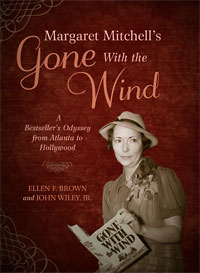Scarlett at 75
An engaging history of Margaret Mitchell’s great American novel
By Rebecca Rego Barry Rebecca Rego Barry is the editor of this magazine.
Margaret Mitchell’s Gone With The Wind: A Bestseller’s Odyssey from Atlanta to Hollywood
Ellen F. Brown and
John Wiley, Jr.
Taylor Trade
379 pages with photo insert
jacketed hardcover
$26.95
Some people are born readers. I was not one of them. But I can trace my subsequent devotion to books to the reading of one title—Gone With the Wind—at the age of fourteen. It was that simple a transition from ‘regular person’ to reader to bibliophile. The plump red paperback affected me in a way that The Iliad or The Good Earth (the reading list of my ninth-grade literature class) decidedly did not. Margaret Mitchell gave me Scarlett fever, and I am eternally grateful.
So it was with great eagerness that I dove into Ellen F. Brown and John Wiley, Jr.’s new history of Mitchell’s masterpiece (Brown is a regular contributor to this magazine). It’s been too long since I revisited the book, or the film for that matter, and I was repeatedly surprised and delighted by the stories Brown and Wiley, Jr. uncovered in the archives. Using the voluminous correspondence of Mitchell and her family, editors, publishing executives, agents, movie producers, literary executors, and fans, an incredibly rich story emerges about all the people involved in this great American success story. Its cast of characters sometimes as riveting as Mitchell’s: the associate editor who never received the credit for ‘discovering’ Mitchell; the over-zealous husband who acted as copyeditor and manager; the underhanded agents who bungled deals and stole royalties. As Macmillan publisher George Brett keenly observed in a letter to Mitchell, “What history [GWTW] is writing in the annals of American publishing!”
Brown and Wiley, Jr. have focused on the book’s wild ride from manuscript to movie, from editorial details to producer David O. Selznick’s repeated attempts to secure sequel rights. Because so much correspondence survived—real letters on real paper, thankfully not destroyed upon her death—Mitchell becomes less of a mystery as well, no longer the shy, reclusive Southern lady, instead a whip-smart woman with a sense of humor who was surprised by her own success and, at the same time, horrified by too much of it.
With such comprehensive research and dynamic writing, this book is certain to appeal to a wide audience of literary, history, and film buffs. GWTW aficionados may already be familiar with one of the authors—Wiley, Jr. is a major collector of GWTW and Mitchell memorabilia and publisher of the Scarlett Letter, a newsletter for fans and collectors. His extensive collection and knowledge of foreign translations of the novel are put to good use here, both in the text and the impressive photo insert. Foreign editions actually played quite a role in the history of GWTW, as Mitchell owned and managed these rights—through World War II, no less—a task that greatly challenged her and her husband, John Marsh.
This year marks the seventy-fifth anniversary of the book’s publication. From Pulitzer to Academy Award, Gone With the Wind is one of the greatest American stories, one that endures with every new generation. Brown and Wiley, Jr. have given us an accessible, highly enjoyable history worthy of that legacy.








